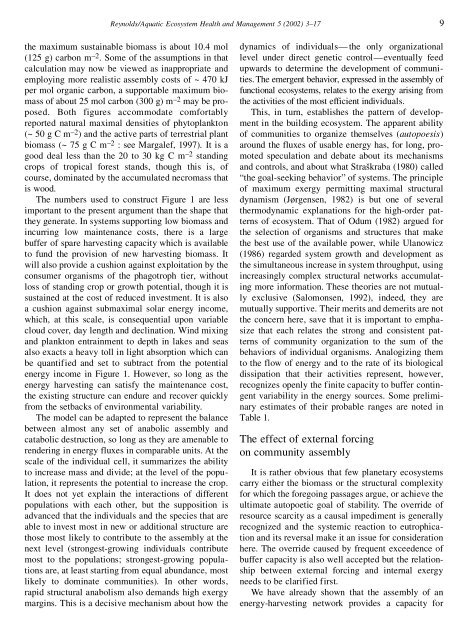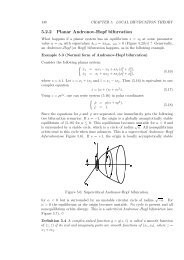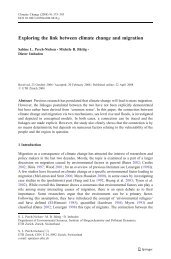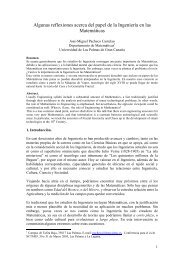Resilience in aquatic ecosystems - hysteresis, homeostasis, and ...
Resilience in aquatic ecosystems - hysteresis, homeostasis, and ...
Resilience in aquatic ecosystems - hysteresis, homeostasis, and ...
Create successful ePaper yourself
Turn your PDF publications into a flip-book with our unique Google optimized e-Paper software.
Reynolds/Aquatic Ecosystem Health <strong>and</strong> Management 5 (2002) 3–17 9<br />
the maximum susta<strong>in</strong>able biomass is about 10.4 mol<br />
(125 g) carbon m –2 . Some of the assumptions <strong>in</strong> that<br />
calculation may now be viewed as <strong>in</strong>appropriate <strong>and</strong><br />
employ<strong>in</strong>g more realistic assembly costs of ~ 470 kJ<br />
per mol organic carbon, a supportable maximum biomass<br />
of about 25 mol carbon (300 g) m –2 may be proposed.<br />
Both figures accommodate comfortably<br />
reported natural maximal densities of phytoplankton<br />
(~ 50 g C m –2 ) <strong>and</strong> the active parts of terrestrial plant<br />
biomass (~ 75 g C m –2 : see Margalef, 1997). It is a<br />
good deal less than the 20 to 30 kg C m –2 st<strong>and</strong><strong>in</strong>g<br />
crops of tropical forest st<strong>and</strong>s, though this is, of<br />
course, dom<strong>in</strong>ated by the accumulated necromass that<br />
is wood.<br />
The numbers used to construct Figure 1 are less<br />
important to the present argument than the shape that<br />
they generate. In systems support<strong>in</strong>g low biomass <strong>and</strong><br />
<strong>in</strong>curr<strong>in</strong>g low ma<strong>in</strong>tenance costs, there is a large<br />
buffer of spare harvest<strong>in</strong>g capacity which is available<br />
to fund the provision of new harvest<strong>in</strong>g biomass. It<br />
will also provide a cushion aga<strong>in</strong>st exploitation by the<br />
consumer organisms of the phagotroph tier, without<br />
loss of st<strong>and</strong><strong>in</strong>g crop or growth potential, though it is<br />
susta<strong>in</strong>ed at the cost of reduced <strong>in</strong>vestment. It is also<br />
a cushion aga<strong>in</strong>st submaximal solar energy <strong>in</strong>come,<br />
which, at this scale, is consequential upon variable<br />
cloud cover, day length <strong>and</strong> decl<strong>in</strong>ation. W<strong>in</strong>d mix<strong>in</strong>g<br />
<strong>and</strong> plankton entra<strong>in</strong>ment to depth <strong>in</strong> lakes <strong>and</strong> seas<br />
also exacts a heavy toll <strong>in</strong> light absorption which can<br />
be quantified <strong>and</strong> set to subtract from the potential<br />
energy <strong>in</strong>come <strong>in</strong> Figure 1. However, so long as the<br />
energy harvest<strong>in</strong>g can satisfy the ma<strong>in</strong>tenance cost,<br />
the exist<strong>in</strong>g structure can endure <strong>and</strong> recover quickly<br />
from the setbacks of environmental variability.<br />
The model can be adapted to represent the balance<br />
between almost any set of anabolic assembly <strong>and</strong><br />
catabolic destruction, so long as they are amenable to<br />
render<strong>in</strong>g <strong>in</strong> energy fluxes <strong>in</strong> comparable units. At the<br />
scale of the <strong>in</strong>dividual cell, it summarizes the ability<br />
to <strong>in</strong>crease mass <strong>and</strong> divide; at the level of the population,<br />
it represents the potential to <strong>in</strong>crease the crop.<br />
It does not yet expla<strong>in</strong> the <strong>in</strong>teractions of different<br />
populations with each other, but the supposition is<br />
advanced that the <strong>in</strong>dividuals <strong>and</strong> the species that are<br />
able to <strong>in</strong>vest most <strong>in</strong> new or additional structure are<br />
those most likely to contribute to the assembly at the<br />
next level (strongest-grow<strong>in</strong>g <strong>in</strong>dividuals contribute<br />
most to the populations; strongest-grow<strong>in</strong>g populations<br />
are, at least start<strong>in</strong>g from equal abundance, most<br />
likely to dom<strong>in</strong>ate communities). In other words,<br />
rapid structural anabolism also dem<strong>and</strong>s high exergy<br />
marg<strong>in</strong>s. This is a decisive mechanism about how the<br />
dynamics of <strong>in</strong>dividuals— the only organizational<br />
level under direct genetic control—eventually feed<br />
upwards to determ<strong>in</strong>e the development of communities.<br />
The emergent behavior, expressed <strong>in</strong> the assembly of<br />
functional <strong>ecosystems</strong>, relates to the exergy aris<strong>in</strong>g from<br />
the activities of the most efficient <strong>in</strong>dividuals.<br />
This, <strong>in</strong> turn, establishes the pattern of development<br />
<strong>in</strong> the build<strong>in</strong>g ecosystem. The apparent ability<br />
of communities to organize themselves (autopoesis)<br />
around the fluxes of usable energy has, for long, promoted<br />
speculation <strong>and</strong> debate about its mechanisms<br />
<strong>and</strong> controls, <strong>and</strong> about what Straškraba (1980) called<br />
“the goal-seek<strong>in</strong>g behavior” of systems. The pr<strong>in</strong>ciple<br />
of maximum exergy permitt<strong>in</strong>g maximal structural<br />
dynamism (Jørgensen, 1982) is but one of several<br />
thermodynamic explanations for the high-order patterns<br />
of ecosystem. That of Odum (1982) argued for<br />
the selection of organisms <strong>and</strong> structures that make<br />
the best use of the available power, while Ulanowicz<br />
(1986) regarded system growth <strong>and</strong> development as<br />
the simultaneous <strong>in</strong>crease <strong>in</strong> system throughput, us<strong>in</strong>g<br />
<strong>in</strong>creas<strong>in</strong>gly complex structural networks accumulat<strong>in</strong>g<br />
more <strong>in</strong>formation. These theories are not mutually<br />
exclusive (Salomonsen, 1992), <strong>in</strong>deed, they are<br />
mutually supportive. Their merits <strong>and</strong> demerits are not<br />
the concern here, save that it is important to emphasize<br />
that each relates the strong <strong>and</strong> consistent patterns<br />
of community organization to the sum of the<br />
behaviors of <strong>in</strong>dividual organisms. Analogiz<strong>in</strong>g them<br />
to the flow of energy <strong>and</strong> to the rate of its biological<br />
dissipation that their activities represent, however,<br />
recognizes openly the f<strong>in</strong>ite capacity to buffer cont<strong>in</strong>gent<br />
variability <strong>in</strong> the energy sources. Some prelim<strong>in</strong>ary<br />
estimates of their probable ranges are noted <strong>in</strong><br />
Table 1.<br />
The effect of external forc<strong>in</strong>g<br />
on community assembly<br />
It is rather obvious that few planetary <strong>ecosystems</strong><br />
carry either the biomass or the structural complexity<br />
for which the forego<strong>in</strong>g passages argue, or achieve the<br />
ultimate autopoetic goal of stability. The override of<br />
resource scarcity as a causal impediment is generally<br />
recognized <strong>and</strong> the systemic reaction to eutrophication<br />
<strong>and</strong> its reversal make it an issue for consideration<br />
here. The override caused by frequent exceedence of<br />
buffer capacity is also well accepted but the relationship<br />
between external forc<strong>in</strong>g <strong>and</strong> <strong>in</strong>ternal exergy<br />
needs to be clarified first.<br />
We have already shown that the assembly of an<br />
energy-harvest<strong>in</strong>g network provides a capacity for






